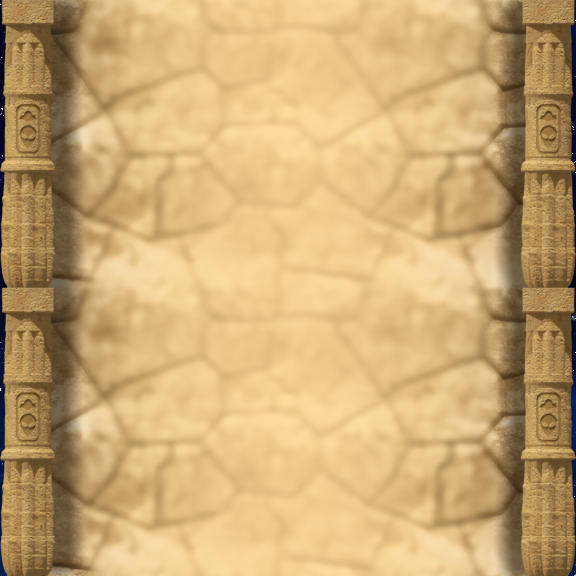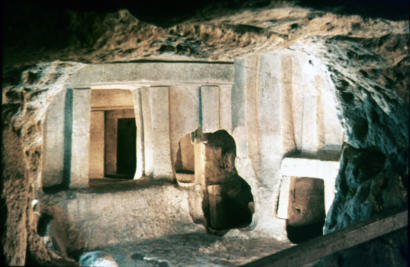





































Megaliths and Stone Constructions
The Hypogeum of Malta
Who,
apart
from
the
intelligent
disbelievers
and
doubters
who
are
in-
terested
by
the
mysteries
of
the
world,
has
ever
heard
of
a
"hypogeum"?
The
word
comes
from
the
Greek
and
means
"below
the
earth"
(hypo
meaning
"below"
and
gaia
meaning
"earth").
The
Hypogeum
of
Malta
is
just
as
mysterious
as
the
tracks
on
the
surface.
The
space
was
discovered
purely
by
chance.
In
1902,
a
builder
found
a
stone
slab
in
the
ground
near
the
quay
wall
of
the
large
port
of
Malta
which
did
not
fit
there.
He
levered
it
up
and
peered
down
into
a
rectangular
shaft
which
disappeared
vertically
into
the
depths.
The
builder
kept
silent.
He
knew
that
there
were
subterranean
com¬plexes
all
over
the
island.
He
also
kept
his
mouth
shut
because
he
feared
the
authorities
might
block
his
building
plans.
Today
the
underground
chambers
have
been
opened
up
to
tourists
-
with
restrictions.
Groups
wanting
to
visit
the
Hypogeum
have
to
register
in
advance.
Guests
are
first
taken
into
a
cinema
where
they
can
admire
impressive
pictures
of
the
rock
chambers.
Then
they
can
go
in
single
file
along
a
prescribed
ramp
to
view
a
part
of
the
complex.
The
Hypogeum
is
different
from
any
other
dolmen
elsewhere
in
the
world,
different
from
the
royal
tombs
in
Egypt.
Passageways
branch
off
the
main
chamber
to
niches
and
smaller
chambers.
Walls
and
ceiling
have
been
worked
in
perfect
Megalithic
style:
clear
lines
and
sharp
edges
on
mighty
blocks.
Above
them
is
a
rounded,
curved
ceiling
in
three
layers,
one
above
the
other.
A
total
work
of
art,
it
is
a
masterpiece
which
does
not
fit
into
the
Stone
Age
at
all.
The
monoliths
extend
smoothly
from
the
floor
to
the
ceiling,
the
niches
have
been
flawlessly
hammered
out
of
the
rock,
the
curved
ceiling
even
in
the
form
of
a
dome.
That
is
totally
alien
to
Stone
Age
thinking.
Who
chiselled
this
complex
out
of
the
rock?
What
was
it
for?
It
is
the
same
as
at
Lixus.
It
was
not
the
Romans,
Greeks,
or
Phoenicians,
because
the
Hypogeum
had
long
been
in
existence
in
their
time.
The
Greeks
were
just
as
unaware
of
the
complex
lying
up
to
12
meters
underground
as
the
Romans.
From
the
rear-most
chamber
of
the
Hypogeum,
a
shaft
leads
into
unknown
depths,
in
which
up
to
7,000
skeletons
are
said
to
have
been
found.
I
cannot check whether this is true.
The
Stone
Age
is
called
the
Stone
Age
because
people
worked
with
stones.
They
did
not
know
metals.
Flint,
at
minimum,
would
have
been
required
to
chisel
the
Hypogeum
out
of
the
rock.
It
is
harder
than
limestone.
But
there
is
no
flint
on
Malta.
The
guidebooks
for
tourists
say
the
Hypogeum
had
been
built
in
three
phases.
It
may
well
be
true
that
in
later
periods
(whenever
that
may
have
been!)
natural
niches
in
the
rock
were
extended
and
smoothed,
but
this
has
nothing
to
do
with
the
main
chamber
and
the
curved,
domed
ceiling.
Source:
Remnants
of
the
Gods,
page 51












































Megaliths and Stone
Constructions
The Hypogeum of Malta
Who,
apart
from
the
intelligent
disbelievers
and
doubters
who
are
in-terested
by
the
mysteries
of
the
world,
has
ever
heard
of
a
"hypogeum"?
The
word
comes
from
the
Greek
and
means
"below
the
earth"
(hypo
meaning
"below"
and
gaia
meaning
"earth").
The
Hypogeum
of
Malta
is
just
as
mysterious
as
the
tracks
on
the
surface.
The
space
was
discovered
purely
by
chance.
In
1902,
a
builder
found
a
stone
slab
in
the
ground
near
the
quay
wall
of
the
large
port
of
Malta
which
did
not
fit
there.
He
levered
it
up
and
peered
down
into
a
rectangular
shaft
which
disappeared
vertically
into
the
depths.
The
builder
kept
silent.
He
knew
that
there
were
subterranean
com¬plexes
all
over
the
island.
He
also
kept
his
mouth
shut
because
he
feared
the
authorities
might
block
his
building
plans.
Today
the
underground
chambers
have
been
opened
up
to
tourists
-
with
restrictions.
Groups
wanting
to
visit
the
Hypogeum
have
to
register
in
advance.
Guests
are
first
taken
into
a
cinema
where
they
can
admire
impressive
pictures
of
the
rock
chambers.
Then
they
can
go
in
single
file
along
a
prescribed
ramp
to
view
a
part
of
the
complex.
The
Hypogeum
is
different
from
any
other
dolmen
elsewhere
in
the
world,
different
from
the
royal
tombs
in
Egypt.
Passageways
branch
off
the
main
chamber
to
niches
and
smaller
chambers.
Walls
and
ceiling
have
been
worked
in
perfect
Megalithic
style:
clear
lines
and
sharp
edges
on
mighty
blocks.
Above
them
is
a
rounded,
curved
ceiling
in
three
layers,
one
above
the
other.
A
total
work
of
art,
it
is
a
masterpiece
which
does
not
fit
into
the
Stone
Age
at
all.
The
monoliths
extend
smoothly
from
the
floor
to
the
ceiling,
the
niches
have
been
flawlessly
hammered
out
of
the
rock,
the
curved
ceiling
even
in
the
form
of
a
dome.
That
is
totally
alien
to
Stone
Age
thinking.
Who
chiselled
this
complex
out
of
the
rock?
What
was
it
for?
It
is
the
same
as
at
Lixus.
It
was
not
the
Romans,
Greeks,
or
Phoenicians,
because
the
Hypogeum
had
long
been
in
existence
in
their
time.
The
Greeks
were
just
as
unaware
of
the
complex
lying
up
to
12
meters
underground
as
the
Romans.
From
the
rear-most
chamber
of
the
Hypogeum,
a
shaft
leads
into
unknown
depths,
in
which
up
to
7,000
skeletons
are
said
to
have
been
found.
I
cannot
check whether this is true.
The
Stone
Age
is
called
the
Stone
Age
because
people
worked
with
stones.
They
did
not
know
metals.
Flint,
at
minimum,
would
have
been
required
to
chisel
the
Hypogeum
out
of
the
rock.
It
is
harder
than
limestone.
But
there
is
no
flint
on
Malta.
The
guidebooks
for
tourists
say
the
Hypogeum
had
been
built
in
three
phases.
It
may
well
be
true
that
in
later
periods
(whenever
that
may
have
been!)
natural
niches
in
the
rock
were
extended
and
smoothed,
but
this
has
nothing
to
do
with
the
main
chamber
and
the
curved,
domed
ceiling.
Source:
Remnants
of
the
Gods,
page 51







